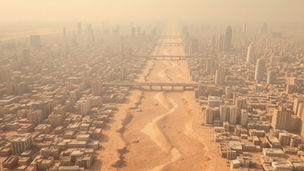Risks & Threats
Our cities are surrounded by an unprecedented array of lingering threats.
The United Nations Office for Disaster Risk Reduction (UNDRR) has cataloged over 300 unique hazards, each with the potential to become a disaster by colliding with unprepared urban populations.
While disasters are theoretically preventable with proper precautions, the reality is "society" is not prepared. This is why disasters still happen. And the lack of preparedness from governments, local governments, and oblivious neighbors will likely become your problem.
Government responses, though well-intentioned, are often sluggish and mired in bureaucracy. Institutional efforts prioritize rural and economically disadvantaged areas, leaving urban middle-class communities to fend for themselves.
Overpopulation, climate change, geopolitical tensions, financial turmoil, and viral mutations create a perfect storm of unpredictability. As disasters grow more frequent, severe, and prolonged, personal preparedness is not just advisable, but essential.
Without a community, you and your family will likely stand alone in the next disaster. Expect government assistance to be overwhelmed by the unprepared masses. Expect the aid you might receive to be underwhelming. Your safety and survival rest on your shoulders.
By preparing today, you enhance your resilience and spare yourself from the effects of potential disasters, protecting not just yourself, but your family's future.
Basic Risk Assessment
1. Identify Natural Hazards
Research the natural hazards that are most likely to affect your city. This includes local phenomena such as hurricanes, tornadoes, floods, earthquakes, tsunamis, etc. Consider how frequently these events occur and what impact they may have on your neighborhood.
2. Examine Technological Risks
Evaluate potential technological hazards, including industrial accidents, infrastructure failures, and cybersecurity threats. Consider nearby facilities that may pose risks, such as chemical plants or power stations, and assess the implications of an incident at these sites.
3. Assess Social and Political Risks
Analyze the social and political climate in your city. This includes understanding the potential for civil unrest, protests, or political instability. Stay informed about local issues that could lead to social upheaval and how it might affect your safety and security.
4. Evaluate Community Resources
Research the resources available within your community to respond to emergencies. Identify local emergency services, hospitals, shelters, and support organizations. Understanding these resources will help you know where to turn for assistance during a disaster.
5. Emergency Management Plans
Familiarize yourself with your city’s emergency management plans. Review how local authorities prepare for and respond to disasters, including evacuation routes, shelter locations, and communication strategies. This will help you align your personal preparedness plans with those of your community.
6. Conduct a Neighborhood Risk Assessment
Conduct a risk assessment of your immediate neighborhood. Consider factors such as building codes, accessibility to emergency services, and the overall resilience of your community infrastructure. Engage with neighbors to gather insights and discuss collective preparedness strategies.
7. Create a Personal Safety Plan
Based on your findings, develop a personal safety plan that addresses the specific risks identified in your analysis. Consider evacuation routes, communication plans, and emergency contact lists. Ensure that your plan accounts for the needs of all household members.
8. Regularly Review and Update Your Assessment
Risks and threats can evolve over time, so it’s essential to regularly review and update your risk assessment. Stay informed about changes in your community, new developments in emergency management, and any updates in local laws or regulations that may affect your preparedness strategy.
9. Engage in Continuous Education and Drills
Finally, engage in continuous education about emergency preparedness and conduct regular drills with your family. This will ensure that everyone understands their roles during an emergency and is prepared to act quickly and effectively.
12 natural hazards around the world
Most natural hazards are typically associated with specific regions due to geographic and climatic factors, however, some types can occur anywhere.
Fact: One disaster can trigger subsequent disasters, amplifying their impact!

Earthquakes
Earthquakes are sudden ground movements caused by the movement or collision of tectonic plates in the Earth's crust.

Volcanic Eruptions
Volcanic eruptions occur when magma from beneath the Earth's crust breaks through to the surface, often due to shifting tectonic plates.

Tsunamis
Tsunamis are large sea waves caused by underwater earthquakes or volcanic eruptions. They can cause severe damage to infrastructure.

Landslides
Landslides are the movement of rock, earth, or debris down a slope due to gravity. They can be triggered by natural events such as earthquakes, volcanic eruptions, and heavy rainfall.

Liquefaction
Liquefaction occurs when saturated soil substantially loses strength and stiffness in response to an applied stress, usually earthquake shaking, causing it to behave like a liquid.

Floods
Floods are an overflow of water onto normally dry land, often caused by heavy rainfall or rapid snowmelt. They can lead to property damage, agricultural losses, and disease.

Storms
Typhoons and hurricanes are powerful tropical cyclones that form over warm ocean waters due to warm sea surface temperatures, high humidity, and low wind shear.

Hailstorms
Hailstorms are precipitation events where balls of ice fall from the sky, often causing property damage and agricultural damage.

Snowstorms (Blizzards)
Blizzards are severe snowstorms with massive snowfall, high winds, and low visibility. These can interrupt mobility, supply chains, and can take out power grids and communication.

Sandstorms
Sandstorms are strong winds that carry sand and dust, often occurring in arid regions. These can cause respiratory issues, water contamination, agricultural losses, and can also bring diseases.

Heatwaves
Heatwaves are prolonged periods of excessively hot weather lasting for weeks or months. These can lead to drought, fires, and agricultural losses.

Wildfires
Fires can occur in nature and in urban areas, both naturally and due to human activity, often causing widespread destruction.
Learn about 32 additional common hazards and find out which ones threaten YOUR city!
4 additional natural hazards, 5 environmental hazards, 8 types of man-made hazards, 4 technological hazards, and 11 conflict-related hazards
+ the factors that affect their intensity, duration, and recovery.
Get our eBook now and learn how to prepare yourself!














